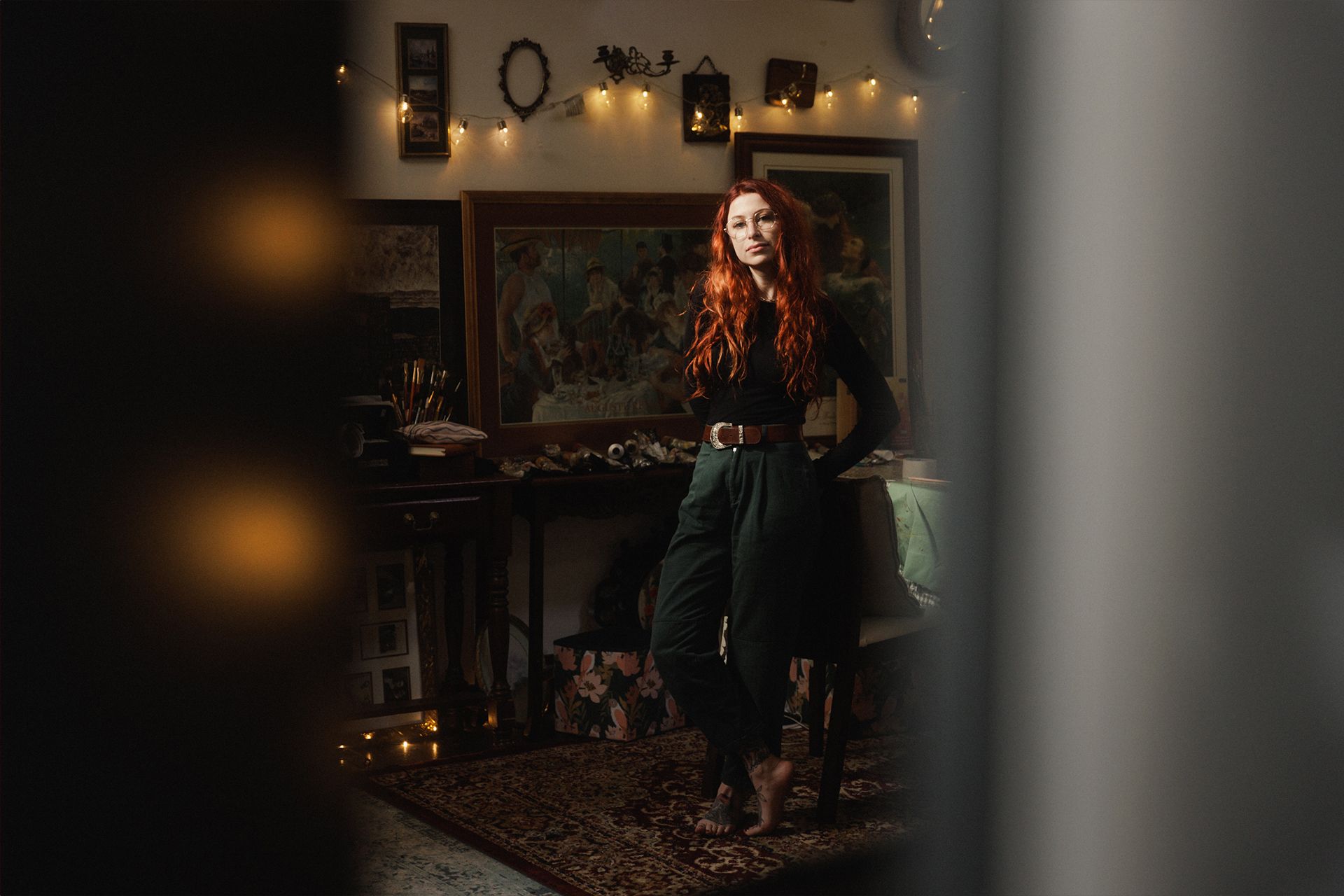What Adelaide artists have
been whipping up over winter.

Adelaide’s streets are bursting with blossom and – besides inspiring us all to stock up on antihistamines – they herald the beginning of a jam-packed arts season. While artists are hard at work all year round, we don’t always see the fruits of these labours until festival season or exhibition time. I took a peek behind studio doors at Adelaide artist collective The Mill to ask a painter, a sculptor and a musician about what their different creative spaces mean to them, what they’ve been working away at over the cold months, and the projects that might emerge in the springtime sunshine.



After opening tattoo studio The Gilded Goblin last year, George Gilles is ready to focus on her first love: painting.
"I always did art growing up," George tells me. "I came back to art after exploring all of the possibilities. Now I know for sure this is what I want to do."
She says she was drawn to tattooing because of the mentorship and artistic development it afforded. "Now I’ve got all of this knowledge I wouldn’t have had previously," she says. "It’s about tattooing, but a lot of it is to do with art."
When I arrive at her studio, George is working on a page of sketches, a smattering of different letterboxes in all shapes and sizes, scrawled words strewn across the top of the page; sadness, letterbox graveyards, crisis, childhood home.
It is part of a project-in-progress ‘percolating’ behind her studio’s doors. We sink into a cosy olive-green couch to chat. The walls of the studio are lined with glowing fairy lights, it feels cosy and warm – like we are chatting in her living room. In fact, George describes her studio at The Mill as a sanctuary, a home away from home where she can put on a pair of headphones and focus. She is a self-described hermit.
"I’m very comfortable in isolation but I’m trying to challenge myself," she says. She set up at The Mill to gain knowledge from the community. She has begun to explore realism while at The Mill through a recent exhibition and a newly established painters collective where painters provide each other skill transfer and friendship. George says learning something new can "feel like pushing a boulder uphill' but mentorship and support energises her.
"It’s so exciting… you’ve got abstract painters, acrylic painters, mixed-medium. There might be a tip or trick shared from someone who is usually outside of my zone, She says.
It’s important that George’s studio feels like home as her current project explores the instability of housing and rental markets. "I’m so lucky to have this space, previously having been crammed into tiny home studios that I haven’t owned – I’ve been scared to throw paint around the place. I’m worried about the carpets," she says. "It’s so amazing that The Mill exists. I have a space to make my own. Having a creative home is integral to get things done. I wouldn’t create without it."
She says owning a home isn’t’ a reality for a lot of people. "I’ve lived in so many homes. I express it in my art because from the age of 12, I’ve lived in something like fourteen homes. I’m constantly moving or being uprooted."
She says house moving boxes inspire her; it’s the materiality which draws interest, the way they are constructed and deconstructed, their temporality and endurance. "The writing on the boxes is crossed out and rewritten," she reflects. 'They are a visual representation of how it is hard to find a sense of home when you haven’t been given one."
Now that light has begun to stream through the studio skylight, George is ready to paint. She’ll start, she says, with the letterboxes. Her aim for this project is to communicate the issue of housing instability in accessible and artistic ways, and to invite others to share their perspectives too.
"It’s not just me feeling this, it’s not just me that has these experiences. I want to incorporate everyone’s stories," she says.
Keep your eyes peeled for ways to get involved.


Chérie de Klerk (My Chérie) is a multi-instrument musician, producer, and singer-songwriter, with an ethereal, melodic, and layered sound. Although there is a peaceful weightlessness to many of her tunes, her messages of authenticity and self-acceptance pack a real punch. Chérie creates at Pretty Good Studio, tucked in the charmingly labyrinthine bottom floor of The Mill. At the time of joining, she was the only person in the space that didn't come from a sound engineering background.
The entryway to Pretty Good is like a well-kept share-house; there’s a plump sofa squeezed into a corner and a mini fridge humming away. Everyone brings something different to the space. Chérie suggests hers is being "chaotically creative". Behind an internal apple-green door is a heavily curtained room neatly packed with recording gear and instruments. A heavy walnut piano takes up one wall, a row of guitars another.
Chérie says my share-house interpretation isn’t far off. In the early days of the pandemic, she worked from home but was soon encouraged to join Pretty Good by owner Michael Carver and the team. "I was lucky enough to have them believe in me… and have me be a non-sound-engineer person coming into space with all the expensive equipment. They trust me not to set it all on fire!" she laughs.
Chérie met Michael while studying pop music at the University of Adelaide and the pair co-wrote her first EP, Healing EP, in the studio.
"In the past I approached the writing process by coming into the studio and writing something on the day. A lot of songs don’t make the cut – which can feel like a waste of time – but one song which doesn’t make the cut may lead to the next," she says.
Chérie says – as the themes of her songs show – that a new creative process is emerging.. "I noticed my songs are quite different if I sit down with my acoustic guitar and write something in that moment," she says. "Then I take it back to the studio to produce it. It’s a different process, and different to co-writing which I’ve done on the last couple of singles I’ve released."
It isn’t just the approach that is fresh, but the music itself. Chérie’s goal is to introduce a new sound and direction.
"I’m maybe more known for my live performances, with an ambient or spiritual flow," she says. "I think maybe for music online there can sometimes be a disconnect… I’m trying to connect the live show with the studio."
She recently travelled overseas to gain life experience and new perspectives. While she didn’t write much while adventuring – her goals were a healthy dose of life experience and living in the moment – she found herself scribbling madly on the journey home.
"On the aeroplane I wrote one of my favourite songs that I’ve written – I had the melody in my head," she says.
‘Did you sing it to everyone on the plane?’ I joke. She chuckles and admits she has done that before. "On a huge choir trip in high school – they made us sing to the plane," she says.
Thankfully, you don’t need to catch a plane to hear My Chérie’s exciting and evolving sound. You can catch her at Space Jams Festival this weekend, or on her Instagram jamming at Pretty Good.


If you’ve walked past The Mill’s wide windows on Angas Street you will have spotted figurative sculptor Juliane Brandt’s charred statues’ faces peering out at you, gold accents glinting in the sun. Juliane waves me into her studio, her hands a seafoam green-grey colour, coated in clay.
Juliane burns wood, shapes and reshapes clay, and works with a little metal (‘to stabilise the sculptures’) while exploring nature’s rejuvenation processes. The wood is carefully singed, adorned with small clay faces, and composed into match-stick-inspired sculptures. Many of them line the walls of her studio and sit atop white plinths, keeping us company while we chat. There is a faint, pleasantly metallic smell of ash in the air.
Juliane moved to Adelaide from Germany around two years ago and set up at The Mill right away. Shewas attracted to The Mill "because of the variety of artists" and ability to work around like-minded people. I motion to the windows, people wandering past as we talk, "Are you used to it? You can see people, but they can also see you!" I exclaim. It feels a little like we are in a museum. Juliane says while it was strange at first it was also a great way to meet people.
"It felt weird in the beginning… eventually you get used to it. And the feedback was amazing," she says. "Little girls or even builders – people you don’t expect to stop – stop."
Juliane’s work is bound to nature’s rhythms. She uses the summer months to scavenge timber from a farm north of Adelaide. The farmer is a friend and unexpected collaborator who appreciates the life Juliane breathes into nature’s discards. The wood they collect there is beautiful.
"Blue gums and red gums where the bark really twists and has lovely shapes," she says.
Winter is burning time, Juliane says, though she often has to wait out the rain for just the right moment. Splinters are commonplace, as is working with a blow torch to ensure perfect scorch patterns across woodgrain. Juliane burns safely at the farm; her studio at The Mill is dedicated to modelling her statues’ clay faces.
Some are charming, playful, others contemplative or powerful. All reach or look upwards.
They "look up into the sun", she says, "attracted to sun and growth."
Juliane might start with a piece of wood, but more commonly with clay itself and the expressions of those around her.
"Faces have always been a fascination because of their expressions – I just love it. You’ll probably end up being one!" she laughs.
Between scavenging and burning, there is also the waiting, Juliane tells me. Waiting for rain to clear, waiting for clay to dry. She says this doesn’t stop her.
"Once I burn the wood in winter I get over-excited, by summer I run out of wood. But that’s probably the time when I’m the most creative, I need to make something out of nothing," she says.
Now we are entering the warm months Juliane aims to create larger, more abstract pieces – if she can figure out how to wrangle them. The wood is heavy, she says, often more so after burning, "One piece we had to demolish with a tractor!" she says.
Walk by and peer in the front windows of The Mill on your next trundle around the city to see her work. And, if you happen to have spare juggling sticks lying around, let Juliane know – she is seeking some for a project!











